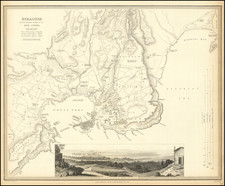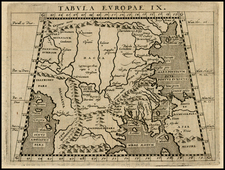Decorative map of the Mediterranean region, based on an amalgamation of Apollonius Rhodius' epic poem the Argonautica, which was based on existing mythology, as well as its successors by Caius Valerius Flaccus and the anonymously authored Orphic Argonautica. Apollonius' poem had a significant influence on Latin poetry, including Virgil's momentous work the Aeneid, with comparisons often drawn between the tragic figures of the latter's Dido and the Argonautica's Medea. The Argo's circuitous journey made land in Europe, Africa, and Asia. This map only appeared in the very late editions of Ortelius' Theatrum Orbis Terrarum.
The central title cartouche depicts the Golden Fleece as a ram hanging from a tree, alongside Aeëtes' barriers to keep Jason from reaching the Fleece: two snarling, fire-breathing oxen with which Jason is tasked to plow the Plain of Ares and a watchful dragon, whose teeth he must sow in the Plain and from which a tribe of warriors sprang.
Many of the locations mentioned in the Argonautica are shown: Iolcos, the Argo's origin, The Symplegades or Clashing Rocks, and Colchis, the destination, as well as the conflicting locations of the return journey between the different versions.
The Acheron River, pictured here in Turkey, was thought by the Ancient Greeks to be another branch of Greece's Acheron River and, in mythology, one of the five rivers of the Greek underworld.
The bottom left cartouche dedicates this map to Charles de Ligne, 2nd Prince of Arenberg, knight of the Order of the Golden Fleece, and a well-known aristocrat of Habsburg Netherlands.
1624LParergon/1641Sxlij (1025 copies printed) (last line second column first text page, right aligned: Anchi- ; last line second column second text page, left aligned, in cursive script: "Antiquitatis monumento fruere.").
Abraham Ortelius is perhaps the best known and most frequently collected of all sixteenth-century mapmakers. Ortelius started his career as a map colorist. In 1547 he entered the Antwerp guild of St Luke as afsetter van Karten. His early career was as a business man, and most of his journeys before 1560, were for commercial purposes. In 1560, while traveling with Gerard Mercator to Trier, Lorraine, and Poitiers, he seems to have been attracted, largely by Mercator’s influence, towards a career as a scientific geographer. From that point forward, he devoted himself to the compilation of his Theatrum Orbis Terrarum (Theatre of the World), which would become the first modern atlas.
In 1564 he completed his “mappemonde", an eight-sheet map of the world. The only extant copy of this great map is in the library of the University of Basel. Ortelius also published a map of Egypt in 1565, a plan of Brittenburg Castle on the coast of the Netherlands, and a map of Asia, prior to 1570.
On May 20, 1570, Ortelius’ Theatrum Orbis Terrarum first appeared in an edition of 70 maps. By the time of his death in 1598, a total of 25 editions were published including editions in Latin, Italian, German, French, and Dutch. Later editions would also be issued in Spanish and English by Ortelius’ successors, Vrients and Plantin, the former adding a number of maps to the atlas, the final edition of which was issued in 1612. Most of the maps in Ortelius' Theatrum were drawn from the works of a number of other mapmakers from around the world; a list of 87 authors is given by Ortelius himself
In 1573, Ortelius published seventeen supplementary maps under the title of Additamentum Theatri Orbis Terrarum. In 1575 he was appointed geographer to the king of Spain, Philip II, on the recommendation of Arias Montanus, who vouched for his orthodoxy (his family, as early as 1535, had fallen under suspicion of Protestantism). In 1578 he laid the basis of a critical treatment of ancient geography with his Synonymia geographica (issued by the Plantin press at Antwerp and republished as Thesaurus geographicus in 1596). In 1584 he issued his Nomenclator Ptolemaicus, a Parergon (a series of maps illustrating ancient history, sacred and secular). Late in life, he also aided Welser in his edition of the Peutinger Table (1598).









![Mappa Maris Mediterranei Fluxus currentes et Naturam Motionum explicans [Map of the flow and motion of the Mediterranean Sea explaining its currents and nature.]](https://storage.googleapis.com/raremaps/img/small/90931.jpg)
![Natolia Detta anticamente Asia Minore . . . 1686 [Shows Cyprus]](https://storage.googleapis.com/raremaps/img/small/76765.jpg)
![[Greece] Tabula Europae X](https://storage.googleapis.com/raremaps/img/small/105280.jpg)

![[Empire of Alexander The Great] Antiquor? Imperiorum Tabula in qua prae caeteris, Macendonia seu Alexandri Magni et Expeditiones exarantur . . .](https://storage.googleapis.com/raremaps/img/small/70608.jpg)
